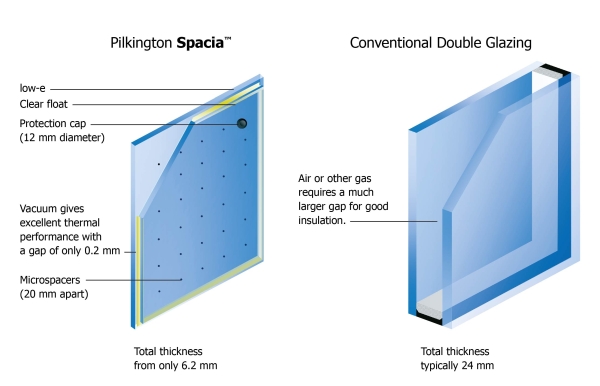Overview
A unique Insulating Glass Unit which provides similar energy efficiency performance as a standard unit, but in a much thinner profile, so it can be used in slim frames - perfect to maintain an older property's original appearance.
The width of single glazing. The warmth of double glazing.
 Our revolutionary Pilkington Spacia™ vacuum glazing technology provides unrivalled thermal performance in an ultra-thin unit that fits seamlessly into traditional and conservation properties. With this innovative unit you can retain the aesthetics by using the original frames. Pilkington Spacia™, provides the most advanced new solution for an age-old problem.
Our revolutionary Pilkington Spacia™ vacuum glazing technology provides unrivalled thermal performance in an ultra-thin unit that fits seamlessly into traditional and conservation properties. With this innovative unit you can retain the aesthetics by using the original frames. Pilkington Spacia™, provides the most advanced new solution for an age-old problem.
How It Works
Pilkington Spacia™ consists of an outer pane of low-emissivity glass and an inner pane of clear float, with a vacuum rather than air or another gas in between. The result is excellent thermal performance from a unit only fractionally as thick as a standard one.
Benefits
The world’s first commercially available vacuum glazing. This extremely thin glazing can be fitted in old style fine frames, maintaining the original appearance of older traditional buildings whilst providing good thermal insulation.
- Thermal performance equal to or better than that of most low-e double glazing but in the same thickness as single glass
- Offers the opportunity to improve energy efficiency in historic buildings hence reduce heating bills
- Four times better thermal insulation than single glazing
- Suitable as a replacement for single glazing in old frames, retaining the appearance of historic buildings and meeting the requirements for conservation areas
- Suitable for other applications where use of thinner, low-weight glazing is desirable, such as sliding box sashes, secondary glazing, or as part of a triple glazed ‘super-window’
- Offers good acoustic performance for lower noise
- Proven solution; installed successfully in the UK and used in Japan for over a decade
- Offers reduced levels of internal condensation compared to single glazing
Brochures